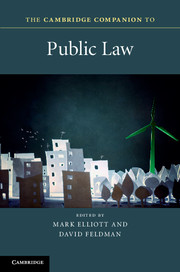Book contents
- Frontmatter
- Contents
- Notes on Contributors
- Introduction
- 1 The distinctiveness of public law
- 2 The politics of public law
- 3 The rule of law in public law
- 4 Legislative supremacy in a multidimensional constitution
- 5 The politics of accountability
- 6 Rights and democracy in UK public law
- 7 Public law values in the common law
- 8 Public law and public laws
- 9 Public law and privatisation
- 10 State architecture: subsidiarity, devolution, federalism and independence
- 11 Soft law never dies
- 12 The impact of public law litigation
- 13 Designing and operating constitutions in global context
- Index
- References
7 - Public law values in the common law
Published online by Cambridge University Press: 05 September 2015
- Frontmatter
- Contents
- Notes on Contributors
- Introduction
- 1 The distinctiveness of public law
- 2 The politics of public law
- 3 The rule of law in public law
- 4 Legislative supremacy in a multidimensional constitution
- 5 The politics of accountability
- 6 Rights and democracy in UK public law
- 7 Public law values in the common law
- 8 Public law and public laws
- 9 Public law and privatisation
- 10 State architecture: subsidiarity, devolution, federalism and independence
- 11 Soft law never dies
- 12 The impact of public law litigation
- 13 Designing and operating constitutions in global context
- Index
- References
Summary
A chapter on public law values in the common law is contingent at a number of junctures. ‘Public law values’ implies a separate ‘public law’, which is a term with no standardised meaning. Indeed, the very existence of a public–private divide is hotly debated, let alone whether it makes sense to talk of a single distinction, or multiple distinctions drawn for different purposes. If one puts those debates to one side and accepts that it is sometimes useful to assign laws into ‘public’ or ‘private’ domains, one finds further debates about the nature and utility of identifying specifically public law ‘values’, as opposed, say, to public law rights or political values.
There are as many different definitions of public law as there are reasons for asking why we might want to categorise a law as public or private, and whether categorisation serves any purpose beyond the academy's convenience of designing workable curriculums. Certainly, most practitioners (even those expert in judicial review matters) would characterise their practices in ways other than ‘public’ or ‘private’ law – they might, for example, describe themselves as child welfare or migration lawyers. Practitioners frequently draw another distinction, describing judicial review applications as ‘public law’ and claims for damages for exactly the same underlying administrative action as ‘private law’.
Any choice between the ‘public’ and ‘private’ labels is important to the actual litigants only if its procedural or substantive consequences matter, and this chapter will note several serious consequences whose rationales are hard to defend. Ideally, what should count are the reasons for asking why one might want to distinguish between public and private law, or between the values of public and private law.
This chapter will leave out of account laws that Parliament enacts for the public benefit, but that apply only to private sector actors or behaviour, obvious examples being the greater parts of statutory criminal law, and market competition law. Indeed, this chapter will deal with statutory law only so far as its underlying values have spilled over into the common law's public realms. Statutes are in one sense always enacted to advance a current perception of the public interest. Also omitted will be any discussion of what remains of the common law of crime and related police powers, although these have been classified as ‘public’ (but not necessarily ‘public law’) since Blackstone's time.
- Type
- Chapter
- Information
- The Cambridge Companion to Public Law , pp. 134 - 152Publisher: Cambridge University PressPrint publication year: 2015
References
- 2
- Cited by

